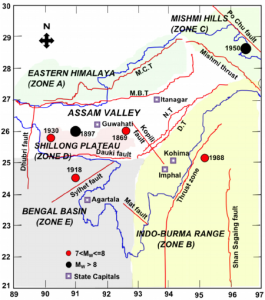Approach :
- Introduction.
- With a map illustration, point out the reasons of NE’s earthquake vulnerability.
- Conclusion.
The NE India continues to experience moderate to large earthquakes at frequent intervals. In the past, it had experienced two great earthquakes – 1897 Shillong earthquake (8.7) and 1950 Assam earthquake (8.6). Very recently, an earthquake of magnitude 6.4 hit near Dhekiajuli in Sonitpur, Assam. This was attributed to the Kopili Fault zone. On an average, the region experiences earthquake of magnitude greater than 6.0 every year.

NE vulnerability to earthquakes :
- NE is located in the highest seismological zone (Zone V). So it is associated with collisional tectonics because the Indian plate is subducting under the Eurasian plate. Due to this, there are several fault zones in the area.
- Mostly, the area is characterized by alluvial soils. They have a higher potential of trapping seismic waves, making the region earthquake prone.
- It is a mountainous terrain, being part of the Himalayas, that is still rising, it has high earthquake potentiality.
- The region has not seen robust development like the rest of India. So in a bid to develop the region & exploit the untapped potential many projects like mining, dam, are done which enhances the earthquake probability in the future.
- Increased use of high-technology equipment tools has made this region susceptible to disruption even by moderate ground shaking.
- Unscientific building plans and constructing buildings on the sloping ground by excavating some part of the hill, enhances their vulnerability.
- There is a considerable knowledge & policy gap regarding earthquakes in the NE.
So an Integrated Disaster Management Plan along with Environmental Impact assessment must be done to reduce the potential damage from earthquake in the region.
